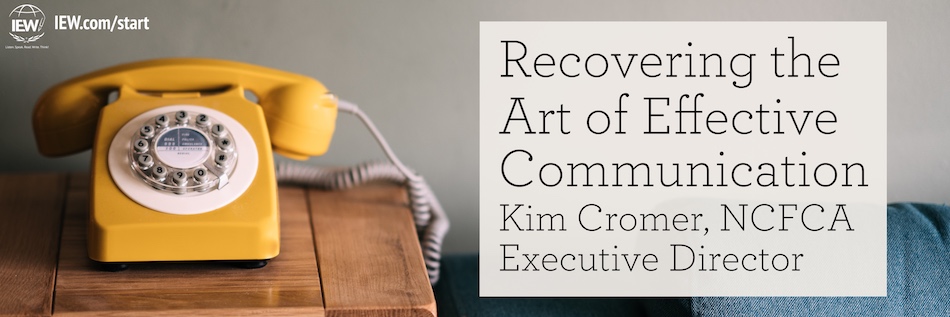 by Kim Cromer
by Kim Cromer
Statista, an online statistics portal for more than 22,500 sources, estimates that in 2018 there are 237.6 million smartphones, 207 million Facebook users, and 67 million active Twitter accounts in the United States. In an age of countless modes of communication, we still struggle to genuinely connect with each other. It’s not a lack of information or the opportunity to share that information that is missing. It’s the effectiveness of the communication taking place that is markedly deficient. Effective communication requires an ability to connect on a personal level with your listener, to engage not only in civil discourse, but also in careful listening and critical thinking.
The formal practice of effective communication has become a lost art. Although we invest years in helping students to learn facts and theories, we rarely take time to intentionally teach what my classical friends call “rhetoric,” the art of persuasive expression. Without the ability to express well-reasoned ideas that encourage thoughtful response from the listener, our students will be unable to engage or impact their culture.
How can we help our students to rediscover the lost art of effective communication? Here are a few suggestions:
-
Discuss important, age-appropriate topics.
Parents, utilize time in the car or at the dinner table, asking thoughtful questions that encourage your students to think critically, identifying their beliefs, and fleshing out underlying suppositions that might surprise them. Teachers, rearrange the usual classroom layout into a circle of chairs to encourage barrier-free conversation about real-life issues.
-
Create opportunities for students to share.
Rigid protocols are unnecessary. Simply let students share from what interests them: a book they love, a trip they’ve taken, or an idea from their imagination. Share with a sibling, the whole family, and eventually in a community setting. Teachers can leverage small group presentations to make public speaking less threatening.
-
Incorporate speech into their curriculum.
Every student has different aptitudes, goals, and aspirations, but every single one of them needs to be an effective communicator. Incorporating speech into your middle, junior, or high school curriculum is an easy way to encourage progress towards this goal.
-
Practice. Practice. Practice.
The old adage “Practice makes perfect” might be a bit overstated, but practice does promote the development of skills. Incentivize that practice and you’ll likely experience greater results. Friendly competition provides goals and rewards for practice and hard work. Feedback from others often inspires improvement and practice in a way that classroom teaching will not.
NCFCA, the National Christian Forensics and Communications Association, is the third largest speech and debate league in the United States, annually serving more than four thousand students ages twelve to eighteen. We help students to develop the skills necessary to think critically and communicate effectively by offering complete resource packages for both speech and debate. In addition, NCFCA offers fifty competitive opportunities across the country where students can hone the art of effective communication. To learn more about NCFCA and its mission, visit www.NCFCA.org or email us at Office@NCFCA.org.
